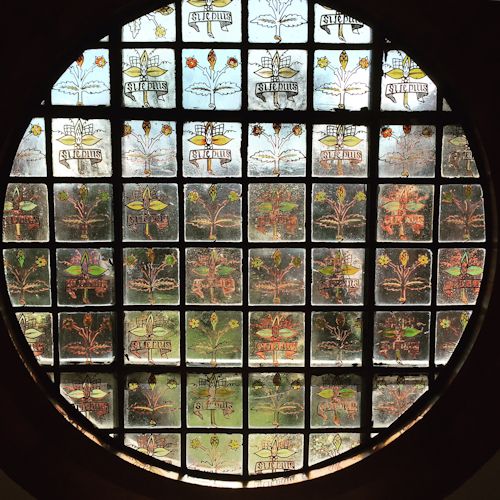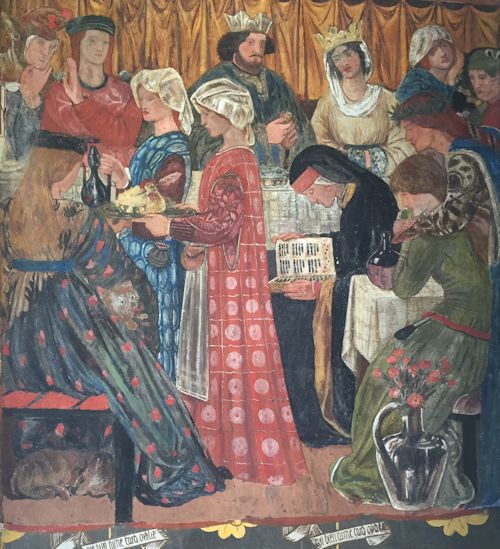Red House, Bexleyheath
“Have nothing in your house you do not know to be useful or believe to be beautiful.”
- William Morris
Red House is incongruous. The large Arts and Crafts house stands shoulder to shoulder with the modern suburban homes of Bexleyheath, each with three or four cars parked haphazardly across their driveways. Today it is strange to think that this area was once rural. When William Morris purchased the plot of land where Red House was built, it was an orchard and meadow. Morris envisioned his new home being surrounded by cherry and apple trees, and this was certainly the case. It is said that in the summer he only had to open his windows and the loose fruit would tumble in.

William Morris was a designer and socialist activist, now known for his famous textile prints and furniture designs. He was heavily influenced by medievalism and formed a close friendship with many Pre-Ralphaelite artists, including Dante Gabriel Rosetti and Edward Burne-Jones.
The design of Red House was a collaborative effort between Morris and his friend Philip Webb. Designing the home was Webb's first effort as an independent architect. Webb and Morris favoured the type of property which blended in and complimented the surrounding areas. Rather than the gaudy, ornamental Victorian architecture which was popular at the time, Morris wanted his home to embody a simple medieval spirit. Thus, according to Morris' biographer J.W. Mackail, the external design of the house was "plain almost to severity, and depended for its effect on its solidity and fine proportion". The windows, for example, were not positioned to be symmetrical but rather placed where they best served the room.
The National Trust, who bought the house in 2003, describes the collaboration between Webb and Morris as "a complex fusion of Morris's romantic utopianism and Webb's practical common sense".

And that was the first thought I had when I walked through the entrance of Red House. An artistic utopia. Clearly, this was a home where art came before anything else. Etched onto some of the panes of glass were hand drawings, some including Morris' motto Si Je Puis (If I Can).
Once Red House was built, Morris went about furnishing it. Almost everything in the house was built as a one-off by Morris or one of his friends. To own anything mass produced would have gone against his ethos completely. Morris and his friends built and designed chairs, tables, cupboards and wall paintings, along with many other furnishings. Some of these are still in the house although many are not original to the home.
When looking at photographs of William Morris, we must separate the image from the man. The image, as is often the case with photographs from this period, shows Morris to be stern and harsh. In actual fact, there is evidence within Red House that his character was the opposite of that. Once you climb the grand staircase and look onto the Byzantine-inspired painted ceiling, you may see a piece of Pre-Ralphaelite graffiti: a smiley face. If anything, this surely proves that Morris and his artist friends had fun decorating Red House.

Red House and its furnishings are one thing. However, what makes any home are the memories that it contains. Red House has plenty. You need only talk to one of the National Trust volunteers and they can reel off stories about Morris and his friends for hours. Somehow the walls embody these stories and it is not difficult to imagine Morris hosting a party or discussing his political views by one of the many fireplaces.
One of these stories which I was told by a National Trust volunteer involves Rosetti, crawling from his bed one night and painting over Morris' motto, changing it from 'If I Can' to 'If I Can't'.
Eventually, like all things, Morris' tenure and ownership of Red House came to an end. Suffering from various medical ailments and being a three-mile journey to the railway station at Abbey Wood and a further long journey from Abbey Wood to his firm's offices in Bloomsbury - which could take up to four hours a day - Morris decided in 1865 to try to sell Red House and moved with his family to Queen Square in Bloomsbury.
Morris never returned to Red House, commenting that the sight of it would be too emotional for him.
By Toby Sligo; Knowledge of London National Trust Reporter
London Time

Follow Us
The contents of this website are the property of knowledgeoflondon.com and therefore must not be reproduced without permission. Every effort is made to ensure the details contained on this website are correct, however, we cannot accept responsibility for errors and omissions.
© Copyright 2004 -
Contact Us | Advertise